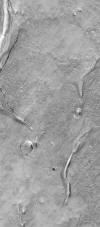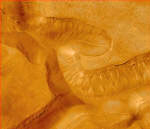|

by David Talbott
from
Thunderbolts Website
Apr 05, 2005

Credit: NASA/JPL/Malin
Space Science Systems
Mysterious domed craters and trenches on Mars point to electric
discharge in recent geologic times.
In our Picture of the Day for
March 25, we compared photographs of
small blue-gray spherules on Mars to the results of laboratory
experiments by plasma physicist C J. Ransom. For his replication of
these Martian “blueberries”, Ransom used a bed of hematite, a
primary constituent of some Martian soils. By blasting the material
with an electric arc, he produced an array of small blue-gray
spherules and fused globules virtually identical in appearance to
those seen on the surface of Mars.
Experiments of this sort will prove invaluable to our understanding
of planetary evolution and geology. An electric arc is a plasma
event, and plasma events are scalable, which means that the same
formations can occur at virtually every scale—from centimeters-long
sparks in laboratories to light years-long “jets” in active
galaxies. Elementary structures of plasma discharge, now well
documented in the laboratory, appear in lightning strikes, in
auroras, on the Sun, in nebulas, and in remote galaxies.
The ease with which electric arcs create the Martian “blueberries”
not only draws our attention to many apparent analogs on Earth, but
to other larger scale formations on Mars. In our Picture of the Day
for March 29 we showed images of a couple dozen “domed” craters on
Mars, which have puzzled planetary scientists for several years. The
spherical domes rest within circular craters and look very much like
the spherules in Ransom’s experiments, which also rested in craters
with partially fused rims.
On Mars the anomalous formations lie in the Arrhenius Region, some
36,000 square kilometer of terrain in the southern hemisphere east
of Hellas Planitia. (More precisely, the region is located between
235° and 240° east longitude and 40° to 45° south latitude.)
Planetary scientists have expressed their wonderment over these
improbable formations while offering equally improbable guesses to
account for them. A recent article published by R. Foxx, et al.,
listed five proposals, two of which (cinder cones and table
mountains) they sought to substantiate as alternative possibilities,
depending on when the domes were created in relation to the surface
material in which they lie.

 There is more to this region than the domed craters, as can be seen
in the pictures above. We’ve placed a more complete picture of the
region (click
image left).
The weirdly “wormlike” formations, exposed within
craggy trenches, have provoked astonishment from scientists and a
host of speculations about “artificial tubes” or “transportation
systems” beneath the surface. But the speculations in the direction
of artificiality or intelligent construction can be excluded through
consideration of similarly grooved and ridged formations in other
contexts such as the Gorgonum Region
(click image right),
just one of thousands of examples. There is more to this region than the domed craters, as can be seen
in the pictures above. We’ve placed a more complete picture of the
region (click
image left).
The weirdly “wormlike” formations, exposed within
craggy trenches, have provoked astonishment from scientists and a
host of speculations about “artificial tubes” or “transportation
systems” beneath the surface. But the speculations in the direction
of artificiality or intelligent construction can be excluded through
consideration of similarly grooved and ridged formations in other
contexts such as the Gorgonum Region
(click image right),
just one of thousands of examples.
Here, in brief, is an electrical interpretation. An
interdisciplinary investigation of data concerning Mars suggests
that in the past the entire planet was subjected to
interplanetary-scale plasma discharge events. Vast regions were
excavated to depths measured in miles. Some of the material was
accelerated electrically into space; some was emplaced back on the
surface to form the ubiquitous but unexpected layering, whose origin
is now debated by planetary scientists.
Diffuse discharges baked the surfaces of implanted layers as in a
plasma oven, giving rise to hardened strata exposed in the walls of
canyons. Arc discharges burnt and blasted craters into the surface.
Lightning many times more energetic than that of thunderstorms we
know today ripped across the Martian landscape. Many of the blast
channels it left are mistaken for flood or lava erosion, a
perception that can be easily corrected through attention to detail.
But in the floors of many of these channels appear glassified
ridges, or “fulgurites”, as in the Gorgonum Region noted above. On a
smaller scale the lightning’s transverse coronal filaments, always
perpendicular to the direction of the primary discharge, formed and
fused the same characteristic ripples in the regolith of the
Arrhenius Region. In some channels, multiple lightning strokes have
cut terraces, each with its faint fulgurite ridges. The existence of
these mysterious ridges is a crucial prediction of the Electric
Universe.
In the electric view, therefore, both the domed craters and the
accompanying trenches of the Arrhenius Region are the result of
cosmic lightning strikes. Where an electric arc “stuck” briefly for
a while to a point on the surface before being extinguished, it
produced domed craters, as in Dr. Ransom’s experiments. Dr. Ransom
has informed us that in his experiments, if a lower energy arc was
extinguished before a complete spherule was formed, the result was a
dome. The fully rounded spherules were the result of higher-energy
discharges. From the Electric Universe viewpoint, the domed craters
and the “wormy” channels simply reflect two common electrical
discharge effects on a surface. We expect to find them in close
association. And we can confidently predict that more extensive
laboratory experimentation will confirm the association in every
important detail.
|